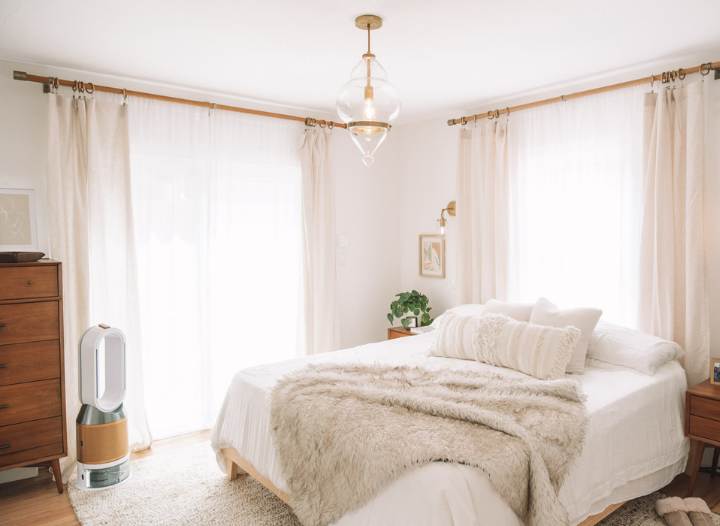Chasing every turn and every new angle, I pull my suitcase up the steps impatiently as views of the city unfurl around me. On one side rise mottled grey walls. I move closer to them as the wind picks up and suddenly feel aware of their magnitude. “You didn’t need to walk,” a member of staff says when he spots my luggage. “There’s a lift for hotel guests.” I hadn’t seen it, but I also couldn’t wait to explore the new 560-metre walkway that wraps around the exterior of this former second world war bunker in Hamburg’s St Pauli district.
The concrete colossus has stood here for eight decades, a stark visual reminder of the darkest chapter in Germany’s history. Constructed on the orders of Adolf Hitler, after the air raids on Berlin in 1940, it was one of several flak tower complexes designed to defend cities against aerial attacks and provide above-ground shelter. They were built – using forced labour – in Berlin, Vienna and Hamburg, but this was one of the biggest. At times, there were 25,000 people inside.
Located in a part of town perhaps better known for its football club and spirited nightlife than its wartime history, the imposing relic reopened on 5 July with a new look. A pyramid-like structure has been added to the top of the listed landmark, with restaurants, a cafe, event spaces and a Hard Rock hotel spread across the five new floors. The crowning glory is the public rooftop park at the end of the walkway, complemented by thousands of plants and trees that hug the modern facade. Known collectively as the Hamburg Bunker, the development represents a radical reimagining of the building.
“A lot of people still don’t know the full history here,” says Urte Ußling from Hilldegarden eV, a residents’ association facilitating public participation in the project. Established in 2015, the group wants to ensure that the story of the bunker is told, recording experiences of local witnesses and creating information boards for visitors (currently only in German).
I meet Urte back at the bottom of the walkway. She has a cigarette in one hand and a watering can in the other, and insists we use the lift to reach the group’s designated space in the new building: “I’ve been up and down those steps too many times recently,” she laughs.
Hilldegarden eV is also involved in the gardening side of things and takes care of a number of herb and vegetable beds (hence the can). The rest is handled by specialist landscape designers and gardeners who have carefully selected, positioned and secured the plants to cope with the unusual, often blustery, conditions.
Alongside the striking visual impact it creates, the roof greening is also meant to be a flagship for climate adaptation and sustainable urban planning. Sensors will collect data on factors such as heat storage and evaporation processes.
The initial idea to transform the bunker was pitched over 10 years ago by local entrepreneur Mathias Müller-Using. He was inspired by the High Line in New York and the ramp that leads to the Niterói Contemporary Art Museum in Rio de Janeiro. This is also not the city’s first extension above an historic building. The glistening glass of the Elbphilharmonie concert hall, visible from the bunker, rises from an old warehouse by the water.
Some of the early visualisations would indicate that the outcome isn’t as green as planned, even if parts of the exterior have been painted in a cool shade of mint. However, Ußling believes the project just needs more time: “Some plants will climb up and around; others will grow down and over,” she says.
In my hotel room, I already have to peer through gaps in branches and leaves to see the FC St Pauli stadium below and the harbour cranes in the distance. The hotel is the first Reverb by Hard Rock in Europe and makes nods to the Beatles, who played many of their early gigs in the neighbourhood. There are also plans to host various live music events here.
after newsletter promotion
The unique atmosphere of this building reveals itself later in the evening when the day visitors have gone. The stillness and space make the setting feel more eerie, particularly on the outdoor level which connects the old and new structures. It was built to be indestructible and certainly feels it.
While many flak towers were taken down after the war, this one stayed. First used as emergency accommodation, it soon became, and still is, a creative centre for media and music. There’s even a nightclub inside. Hamburg’s other tower, in Wilhelmsburg, is now used to produce energy (there’s a cafe there too), while in Berlin a partially destroyed structure can be visited on a tour with Berliner Unterwelten eV (Berlin Underworlds Association).
It’s hard to judge how the numbers in St Pauli will develop over the coming weeks and months, but on the opening weekend there’s a real buzz. By Sunday afternoon, a queue stretches all the way back to the nearby underground station and the entrance to the walkway is temporarily closed.
Once again, I’m advised to take the lift to reach the hotel. I’m glad I decided to walk when I first arrived, even with a suitcase.
The trip was provided by Hamburg Tourismus. Rooms at the REVERB hotel start at £127 a night. Entry to the walkway and garden at the Hamburg BUNKER is free.







